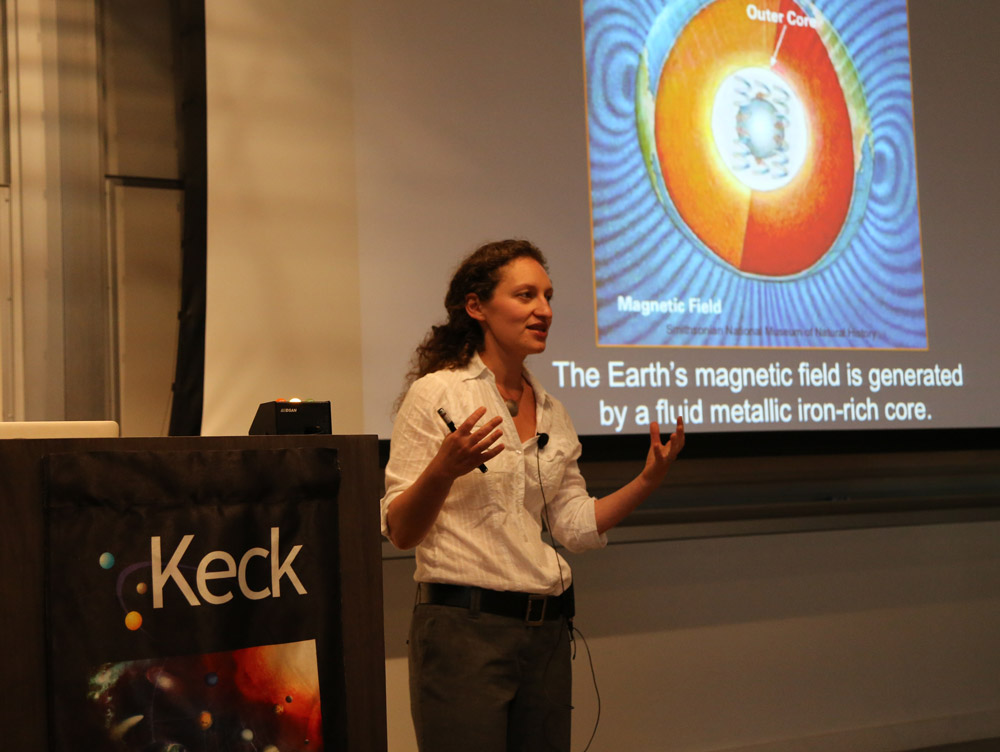Workshop Overview:
Planetary-scale magnetic fields are a window to a planet’s interior and provide shielding of the planet’s atmosphere and surface for life. The Earth, Mercury, Ganymede, and the giant planets of the solar system all contain internal dynamo currents that generate planetary-scale magnetic fields. In turn, these internal dynamo currents arise from differential rotation, convection, compositional dynamics, or a combination of these in a planet's interior. Extrapolated to extrasolar planets, knowledge of a planet’s magnetic field places constraints on the thermal state, composition, and dynamics of its interior—all of which will be difficult to determine by other means—as well as potentially crucial information about the extent to which the surface of a terrestrial planet is shielded from cosmic rays and potentially habitable.
This study will assess the current state of knowledge about planetary magnetic fields, for both solar system and extrasolar planets; track the progress of the new ground-based instruments, particularly those in the radio (e.g., the Low Frequency Array [LOFAR], Long Wavelength Array at Owens Valley Radio Observatory [LWA-OVRO]), as they acquire their first data on extrasolar planetary systems; develop complementary observing strategies from existing optical/UV telescopes; and feed that forward to form an observational strategy for current and future radio and UV telescopes from both the ground and space.
Numerous observational manifestations of planetary magnetic fields have been suggested. Electron cyclotron maser emission, resulting from an interaction between the planetary magnetosphere and the solar wind in the planetary magnetic polar regions, has been detected from all of the gas giants and the Earth in the solar system. In addition to electron cyclotron maser emission, planetary auroral regions produce ultraviolet emission, which may also be detectable over interstellar distances. There have been suggestions in the literature that the inflated radii of some “hot Jupiter” extrasolar planets may be due, in part, to Ohmic dissipation within the planet as the planetary magnetosphere moves through the magnetosphere of its host star. Finally, the magnetospheres of “hot Jupiters” have been predicted to produce a bow shock that would be detectable as an asymmetric transit light curve.
The detection of extrasolar planetary magnetic fields will inform the following:
- Planetary Interiors: For the solar system planets, the composition of the conducting fluid ranges from liquid iron in the Earth’s core to metallic hydrogen in Jupiter and Saturn to perhaps a salty ocean in Uranus and Neptune. Likewise, radio detection of an extrasolar planet would constrain the planet's internal composition, insofar as it would require the planet to have a conducting interior. Combined with an estimate of the planet's mass and radius, one could infer the interior composition by analogy to the solar system planets.
- Planetary rotation: The rotation of a planet imposes a periodic modulation on the radio emission, as the emission is preferentially beamed close to perpendicular to the local magnetic field and will change if the magnetic and spin axes of the planet are not aligned. For the gas giant planets in the solar system, this modulation defines the rotation periods.
- Planetary Satellites: Jupiter's radio emission is also modulated by the presence of its satellite Io, and more weakly by Callisto and Ganymede. As the Jovian magnetic field sweeps over a moon, a potential is established by its v x B motion in the Jovian magnetic field. This potential drives currents along the magnetic field lines, connecting the moon to the Jovian polar regions, where the currents modulate the radio emission. Modulations of planetary radio emission may thus reveal the presence of a satellite.
- Atmospheric retention: A common and simple means of estimating whether a planet can retain its atmosphere is to compare the thermal velocity of atmospheric molecules with the planet's escape velocity. If the thermal velocity is a substantial fraction of the escape velocity, the planet will lose its atmosphere. For a planet immersed in a stellar wind, non-thermal atmospheric loss mechanisms can be important, as the typical stellar wind particle has a supra-thermal velocity. If directly exposed to a stellar wind, a planet's atmosphere can erode more quickly. Based on Mars Global Surveyor observations, this erosion process is thought to have been important for Mars’ atmosphere and oceans.
- Habitability: A magnetic field may determine the habitability of a planet by shielding it from cosmic rays and the stellar wind. In addition to the erosive effect of the stellar wind on the atmosphere, if the cosmic ray flux at the surface of an otherwise habitable planet is too large, it could cause cellular damage or frustrate the origin of life altogether. Mars is again a good example here: Mars may have been habitable in its past when it had a magnetic field to protect its atmosphere and surface water.


























